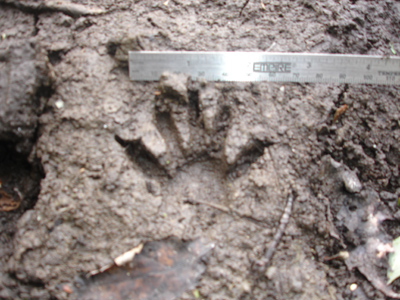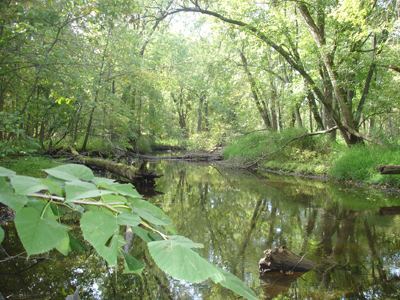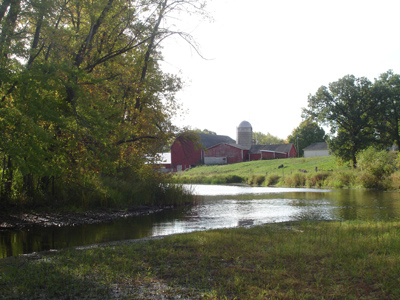FENCEROWS...Kettle Moraine Cougar
By John Luthens
The stories have trickled slowly out of southeastern Wisconsin’s Washington County, flowing down through the county like the headwater branches of the Milwaukee River. They never seem to pick up all that much momentum, like the Milwaukee does further down when it widens and swirls itself into the harbor of its namesake city.
A man in West Bend saw the long- tailed cat in May when he was walking his dog in a neighborhood park. The local news covered that one, even though DNR authorities who investigated found no trace.
A corralled horse was slashed, a lake property owner captured the silent predator on a trail camera, and reportedly it was seen roaming a nature preserve in the small town of Newburg. I’m not saying they aren’t true stories, but I’ve been unable to track down the source of any of them. That’s usually the way legends start.
I have seen verified trail-cam photos of cougars passing further north in Wisconsin, silently padding through the night, either oblivious or non-caring that they’ve made motion-activated photojournalistic headlines.

A raccoon track pasted in the river-bottom mud.
I’ve never stood witness to a cougar in the wild. I’ve spent a lot of my life in the backwoods outdoors of Wisconsin, and the closest I’ve come is a public zoo display. I’m certain I’m not alone in that respect.
Few have witnessed a wild mountain lion, puma, devil cat, or catamount; or Puma concolor, if you prefer the scientific name. In fact, the cougar holds the Guinness record for the animal with the highest number of names. It has over 40 names in English alone.
Doing an internet search, I came up with 30 pages of web-printed material on the cougar, along with another 117 cited references. There’s even a Wisconsin DNR page devoted to cougar habitat, sightings and mistaken identity.
In a nutshell, the cougar is a powerful animal, highly adaptable to almost any environment, requiring a steady diet of prey (deer, turkey, and grouse being among the favorites). It’s found throughout the world, but apparently doesn’t particularly want to be seen setting up shop in Wisconsin. Wildlife experts say mountain lions simply pass through our state from a breeding population in South Dakota. They are heading east, and I’m not entirely certain why they simply pass through like tourists.
The sightings usually involve young male lions looking to expand their range, looking for breeding opportunities, even though the females presumably stay put in South Dakota. Maybe the male lions are like Forest Gump in the movie. They run until they reach the East Coast, and when the see the Atlantic, they simply turn around and head back the other way.
All this leads to the fact of the particular rumors of a cougar in the Northern Kettle Moraine State Forest, in Washington County, specifically along the upper Milwaukee River corridor. I’ve continued to hear the legends of cat sighting throughout the summer. Maybe it’s because I know a few locals in the area, whom I keep in contact with on a steady basis; maybe that’s why I hear the stories, and maybe they’re sometimes exaggerated or simply cases of mistaken identity. But there are also farmers in the area who swear to sightings of a big cat, and those farmers aren’t the type to float around stories for the notoriety it might bring.
The stories sent me into cyber-world, searching the web, brushing up on everything I could find about cougar habits, cougar tracks, even cougar scat. I haunted the libraries and checked out books. My daughter asked me if I was becoming obsessed.
I discovered a book called “Shadow Cat”, a compilation of stories and essays about disappearing habitat and the necessity for cougars to have wide, undisturbed ranges. The stories were O.K., but the opening passage quote was really the pinnacle of the book.
It was a quote by Gary Snyder, whom I hadn’t heard of, but assumed was famous for something. It read: “The wild is perhaps the very possibility of being eaten by a mountain lion.”
That was it. I couldn’t take it anymore. I packed supplies for the day and went in search of a cougar. And that was how I found myself, on a bright, windy autumn day, just south of the city of Kewaskum, whose town slogan happens to read, “Gateway to the Kettle Moraine.”

A flood-plain forest of the Kettle Moraine.
I started on the Milwaukee River trailhead of The Ice Age Trail. The trail stretches through Washington County for almost 45 miles. It reaches into State Forest land that encompasses 30,000 acres, with the lower regions stretching along the east-west river branches of the Milwaukee. The trailhead speared north, and was within a mile of the farmland where the latest cougar report came to my attention some weeks back.
The Milwaukee River itself, in the Ice Age Trail region, is as untouched a large watershed as you’ll find. There’s a fine diversity of working farms, idle agricultural land, and native hardwood forest. The majority is State Forest land that is so vast it could take years to explore it all. I didn’t figure to see a cougar, but I thought the possibility if a track in the mud of the river bottoms might not be out of the question.
Cougars are no different than deer, wolves, bears or humans. They will take the path of least resistance if the opportunity presents itself. The Milwaukee river corridor is a prime trail.
Low water conditions coupled with the removal of dams had created a floodplain along the forested river bottom of the upper Milwaukee River. Large oaks, maple and cotton wood creaked in the wind, and the trees played tricks with the sun’s shadows. I’m not usually jumpy in the woods, but after reading countless cougar stories for weeks, I found myself looking high in the branches and deep into the marsh grass with every step, as I wound deeper into the river forest and checked the mud flats for tracks.
I found plenty of raccoon sign, and plenty of deer sign. As I stooped over to photograph a raccoon track, with a ruler placed along the track for size comparison, a buck jumped out of the marsh grass across the river from me, bounding out of his bed and through the high grass.
It was a small bodied animal with a wide low rack, and I kicked myself for not bringing my bow, but I was so freaked by the close appearance of the animal and the creaking trees, that I probably would have dropped my bow into the river.
I’d taken along a large mammal report form from the DNR, just in case, and plastic baggies for any samples, and I was properly prepared to document any findings. But the day turned into a seven hour foray along the river, with nothing to show but a ton of nice, wild country and a jumbled bunch of nerves.
It was a day of wandering among autumn plants, flowers, and insects. I explored new territory, and that’s plenty enough to ask out of a day. I doubt if I was in any danger of being eaten by a mountain lion, but it added a wild element of high-adventure.

Farmland of the upper Milwaukee River.
I’ve occasionally been swatted by our family cat, who lays in wait with a hidden ferocity she reserves especially for me. I don’t think cats like me much, so it might have been a good thing I never encountered the fabled Kettle Moraine cougar.
I did find a fine specimen of scat, complete with digested animal hair. The remains of two raccoons lay nearby. When it came down to it, I couldn’t bring myself to put it in my sample baggie. I guess I’m not hard-core enough to be a cougar tracker.
I took a picture, which I won’t include with this column for your viewing pleasure. Let me know if you want to see it. I’ll email it to you. It could be the stuff legends are made of.









